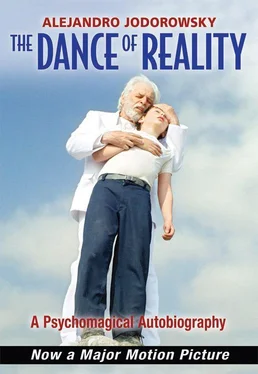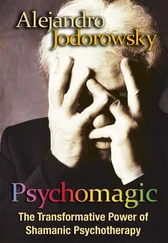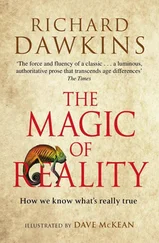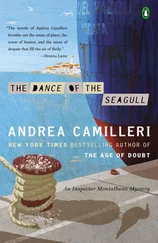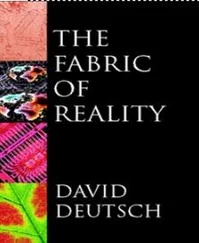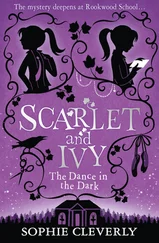“What are you doing, Christina?”
She slowly turned her head and, still stroking the air, looking at me with glazed eyes, said anxiously, “Do you see? I’m finishing. When God took my son, the Virgin of Carmen came to me and told me, ‘Make me a sculpture of me from the air. When it’s finished and everyone can see it, your child will rise from his grave, alive again.’ You see it, right? Tell me!”
What could I say? I did not know how to lie. It was the first time I had been in contact with madness, the first time I had seen a person acting as a unit without observing herself, without a social mask. Terrified, I felt frozen to the spot. The cold night wind, blowing down from the mountains, started sighing. Cristina embraced her invisible sculpture, distraught. “No, I don’t want you to take him, damn you!” She seemed to be struggling against a hurricane, then, sobbing, put her face on the table with her arms dangling as if her hands were empty. After some seconds, she returned to being the person I knew. She gave me a glass of water, peeled an apple for me, and took me to bed. She stayed by me until I dissolved into sleep.
My second encounter with magic was in Santiago. Our group of young poets attracted many older homosexual intellectuals. Sometimes they were painters, sometimes writers, sometimes university professors. They had a unique culture, spoke several languages with French being the preferred one, and were very generous. Knowing us to be heterosexual they fell in love platonically, revered us in silence, and in order to enjoy our youthful presence often invited us to the German pub to drink beer, eat sausages, and listen to a string trio accompanied on the piano by Pirulí (Lollipop), a lanky effeminate man with hair dyed a violent yellow who played Viennese waltzes. Among these men was Chico Molina, about fifty, short in stature with a broad chest, slender legs, and tiny feet, who seduced our minds with his encyclopedic knowledge. He was a polyglot, could read Sanskrit, and knew every author or artist that one could name. One day, apparently more drunk than usual, he revealed to us that his intimate millionaire friend, Lora Aldunate, owned a magic mirror made in the fourteenth century. He had apparently bought it in Italy, in Turin, a city consecrated to the devil. If certain secret rituals were performed in front of it, the mirror would stop reflecting reality and would show old reflections. Molina swore to us that he had seen, more clearly than on film, a night scene in a forest in which naked women kissed the anus of a billy goat beneath the light of the full moon. Excited by such revelations, we rushed him out of the German restaurant and took him to the home of Lora Aldunate, which was very close by. We started yelling, asking him to let us in, demanding to see the magic mirror. A tall, distinguished, deathly pale man opened the blinds on the second floor and emptied his bedpan full of urine onto our heads. “You indecent drunks, don’t play with magic! You will never see my mirror! When I die, I’ll take it to the grave, locked in my coffin with me!” Molina looked at us with a wide smile on his simian face. “See? It’s true. I never lie. As Neruda said, ‘God forbid me from making things up when I’m singing!’”
Some time later, we learned that he was a pathological liar and fraudster. For months he had sparked our admiration by reading us chapters from his magnificent novel The Swimmer without a Family in exchange for invitations to dinner, until one of our friends, a philosophy professor, discovered that it was a translation of Herman Hesse’s The Glass Bead Game, which had not yet been published in Spanish. Well then, did the magic mirror exist, or was it a lie made up with Lora Aldunate’s complicity? His anger had seemed sincere when he opened the blinds, but Lihn raised a doubt: no one fills a chamber pot with urine in a single night; it was hard to believe that such a distinguished man would accumulate so much of the yellow liquid just for the pleasure of collecting it. But countless depravities exist.
I have encountered this kind of certainty exhibited by Chico Molina, claiming something reason cannot accept is the truth, in almost all people who say they have had contact with higher planes. It was after this that I began to consider that lying, apart from its despicable quality, also has a mystical utility. In the Bible, in Genesis, Jacob cheats his brother Esau by persuading him to sell his birthright for a meal of lentil stew. He then takes advantage of his father’s blindness to impersonate his brother and get his blessing. Later, it became clear to me that lying, or “sacred trickery,” as I called it, is a technique used by all masters and shamans.
Thanks to Marie Lefevre, in 1950 I had my first encounter with the optical language that is the Tarot. At what age had Marie arrived in Chile? She never wanted to tell us. When we knew her, she was over sixty years old. A small woman made up and dressed like Dracula’s daughter with her long gray hair dyed with a blue rinse, she lived in a basement with her lover Nene who was an unemployed and uneducated youth of eighteen years, but of an angelic beauty. After having heated metaphysical discussions at Café Iris, we poets would arrive drunk around three in the morning at her basement, knowing that a pot full of tasty soup would be waiting for us there, heating up on a slow fire. Nene, naked as usual, with a pink silk ribbon tied in the shape of a butterfly around his penis, slept soundly. She, who never slept, got up to serve us cups of the delicious soup made from all the leftovers that the nearby restaurant gave her in exchange for reading the Tarot to customers. Lefevre had drawn her own deck of seventy-eight cards. Instead of cups, swords, wands, and coins, she shuffled sopaipillas (coins), gourds of maté (cups), Shivalingams, male and female genitalia forming a unit (wands), and eyes above a triangle (swords). I remember some of her major arcana: she had a cowboy and a beautiful cowgirl in place of the Emperor and Empress. The Priestess was a Mapuche machi. The World was a map of Chile. Despite the ingenuousness of this deck, she gave readings of a surprising psychological accuracy, her very Chilean language contrasting with her strong French accent. I had removed money from my life without feeling poor, surviving on adventure, caught up in the present without ever thinking about tomorrow; for me, she predicted hundreds, thousands of trips all around the world. It was hard for me to believe her, and yet her prediction came true. To Carlos Faz, an exceptionally talented painter, she said, “Never travel by sea!” A year later on his way to America at a stop in Ecuador where the passengers were forbidden to disembark Carlos, drunk as usual, jumped from the ship toward the dock, misjudged the distance, fell into the water, and drowned. He was twenty-two. For me, this lady was an example of generosity, freedom, and subtlety. She did not tell Faz that he was going to drown, which would have become an order to commit suicide (the mind tends to fulfill predictions), but warned him of danger, leaving him the possibility of either confronting it or not. She also taught me that one can create miracles for others: somewhere in this world, there was a well-intentioned woman who would receive you at any hour with a humble smile on her lips, give you a bowl of soup, and read the cards for you, for free, just out of love for human beings.
Another teacher who changed my worldview was Nicanor Parra. When I met him I was a teenager, he a grown man, a mathematics professor at the School of Engineering. As a revolutionary reaction against the emotional poetry of Neruda, Pablo de Rokha, García Lorca, and Vicente Huidobro, he had declared himself an anti-poet. For us young people, his emergence in the literary world was akin to that of a messiah. After my awkward encounter with him at Café Iris, my pathological shyness kept me from visiting him. Stella Díaz had to help me. Making what for her was an immense concession, she covered the flames of her hair with a beret. “Nica doesn’t want me to show up with my hair uncovered. He says that redheads drive the students mad.” And she took me into the territory of the great anti-poet. Parra was an unassuming man, and the admiration of young poets encouraged him. We met many times, also with Enrique Lihn present. We talked in a small bar near the National Library, over that wonderful drink that is sweet chicha. One day Nicanor handed me a large envelope full of typewritten sheets of paper of different sizes. “They’re various writings, a sort of literary journal. Can you organize them for me? I’ve reread them so many times that I can’t see their value. I labeled them ‘Notes on the edge of the abyss.’” To receive such a gesture of confidence from a consecrated poet was like a spiritual explosion for me. I spent many nights locked away, reverently reviewing these unpublished texts, sorting them by subject, eliminating repetitions. In a concise style—“I want a clinical-photographic art”—the poet described his inner life in prose. After fifteen days I returned the notes to him, copied onto regular size sheets of paper, in an order that seemed perfect to me. Parra never published them, nor did he ever speak of them again.
Читать дальше
